Poverty in Perspective: a typology of poverty in Scotland
Sets out 13 different ‘types’ of poverty across three life stages: families with children, working age households without children, and pensioner households.
Poverty types: Older age
The analysis of the older people life stage revealed five poverty types:

The five segments above show the proportions of low income households in the 'older age' life stage that are in each poverty type.
This chapter now goes on to describe the households in each poverty type, explaining the combination of indicators that households face. Given knowledge of how particular forms of poverty interact for households, there is also discussion of how policy makers and service providers can reach and help households in each poverty type.
Older age: 'Ill health'
Who they are
This group of low income older households is small, but the critical factor that shapes this group's experience of poverty is that the vast majority are in poor health or disabled - or are carers of other people. These households face a host of issues as a result: financial struggles, social isolation and lack of mobility to name just a few. Furthermore, this group are much more likely to live in deprived neighbourhoods, and three quarters live in social rented housing.
How to reach them
This group are hard to reach, owing to the fact that they are isolated - three quarters lack internet access at home, and a similar proportion do not have a car. Health charities such as Alzheimer Scotland, Carers Trust Scotland and Diabetes Scotland may not already have contact with people in this group, but they are in the best position to reach out. This could perhaps be achieved through partnerships between organisations like these and housing associations, to enable health charities to identify older social tenants who are digitally and socially disconnected as a result of disability or being a carer.
Breakdown of poverty indicators for the 'ill health'
poverty type

How to help them
The focus for this group should be on improving housing quality, reducing isolation and providing support for carers.
Less than one in ten of this group are aged 80 or above, and half are below 70. Given that life expectancy is increasing, people in this group could be facing an extended period of poor health in poverty. Quality of life for this group needs to be addressed - more activities, more opportunities to socialise, and a more accessible urban space would make all the difference for older people who are carers or disabled.
The longer term picture for carers also needs consideration: once an older person becomes bereaved, their own health often declines and they can become more isolated (Soulsby and Bennett, 2000). Measures could be taken before bereavement to prevent this decline, such as helping the carer to expand their support network by enabling them to connect with other carers and community groups.
Socio-demographic characteristics of the 'ill health'
poverty type
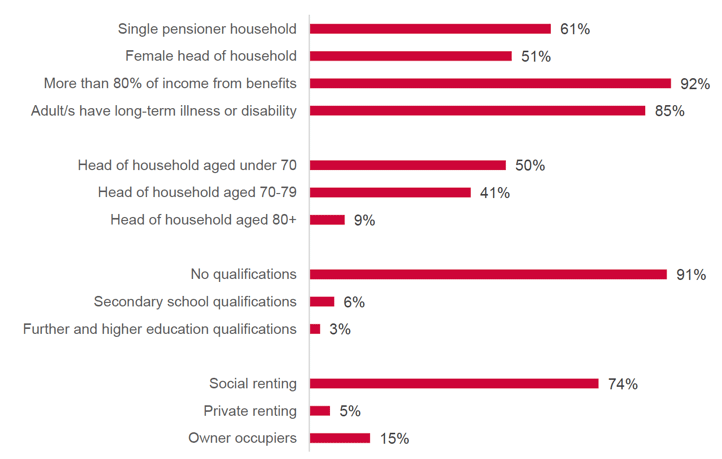
Older age: 'Left alone'
Who they are
Older people in this group are similar to those in the previous group in that both are likely to have an illness or disability. However, the fact that people in the 'left alone' group are older (nearly two thirds are over 80) may suggest that their ill health is simply a symptom of their increased age. Most (90%) are living alone, so it is likely that many are widowed - and four in five are women, reflecting the difference in life expectancy between women and men. Unlike the 'ill health' group, the majority of people in the 'left alone' group own their own homes, and fewer report financial hardship. Nevertheless, both groups face a lack of mobility and social isolation.
How to reach them
The fact that this is a socially isolated, home owning group makes them difficult to reach. The most effective way might be through health services and health charities, as two thirds of the group have a health problem.
Breakdown of poverty indicators for the 'left
alone'
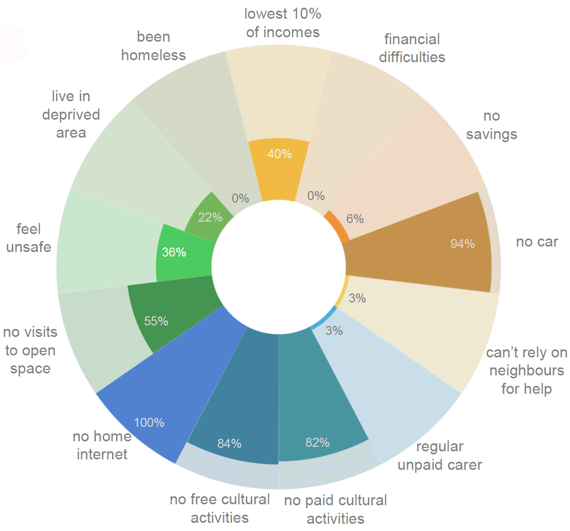
How to help them
The key focus of interventions for this group should be on tackling their sense of isolation and perhaps tapping into their housing assets.
The range of opportunities for older women to socialise and create new networks are already well developed in many communities - the challenge is to reach those who often have no way of finding out about these services.
However, a more effective strategy for the particularly isolated home owners might be to support their move into retirement housing. 'Building Companionship' showed that older people living in retirement housing developments were much more likely than older people in general to say they did not feel lonely, to have socialised recently, to report feeling a sense of community, and to say there are enough social events for them to enjoy (Wood and Salter, 2016).
Of course, a move to specialist retirement housing is not for everyone, but there are likely to be many in this group who could be supported to downsize more generally. While this would clearly benefit the whole of the housing chain, it would also benefit older people in this group - not only by freeing up some of their housing assets to boost their retirement income, but also perhaps to tackle their isolation by enabling them to move to a more accessible, better located and/or more easily maintained smaller property, which could help them leave their homes more often.
Socio-demographic characteristics of the 'left
alone'
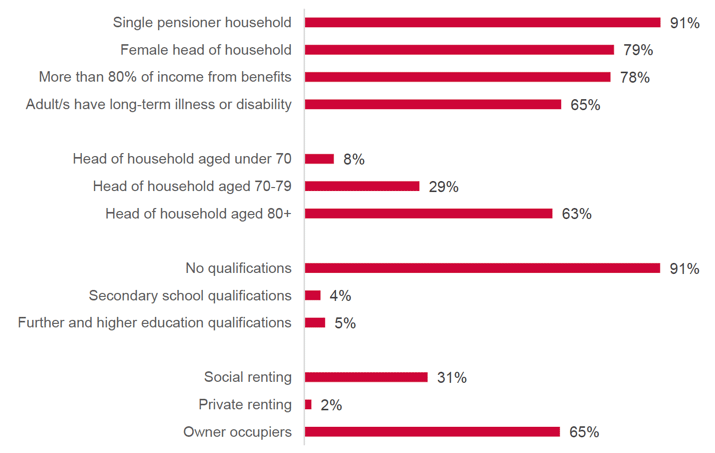
Older age: 'Socially disengaged couples'
Who they are
'Socially isengaged couples' are very similar to the previous, 'left alone' group, but with one key difference: 'socially disengaged couples' are primarily two person households. This fact explains many of the other differences between the groups: 'socially disengaged couples' have a better health profile than the 'left alones', as older couples often do (evidence suggests older couples tend to look after each other and keep each other mentally active). They are also more mobile, able to drive a car and more socially engaged (though relatively disengaged overall).
'Socially disengaged couples' are slightly younger than their 'left alone' counterparts. It is highly plausible that people in the 'socially disengaged couples' type become people in the 'left alone' type when their partner dies and their health deteriorates. This has important implications for policy interventions for this group.
How to reach them
This group is somewhat isolated in that they do not participate in cultural activities. However, the majority have internet access, a car and are mobile - so, with the right kind of activities on offer, they could become more engaged. Offering more activities that appeal to older people locally could encourage this group to engage with their communities, making them easier to reach. Social media and online forums may be another useful way to reach out.
Breakdown of poverty indicators for the 'socially
disengaged couples'
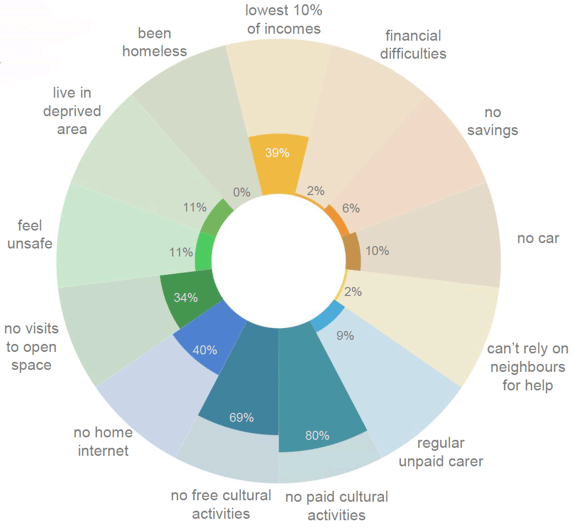
How to help them
Barring their lack of participation in cultural activities, 'disengaged couples' are not especially deprived. However, their isolation as a couple renders them vulnerable as individuals - the partner left behind is at risk of the deprivation factors associated with the 'left alone' type outlined above when they are widowed. Therefore, the focus for this group should be on prevention measures - to build resilience, and encourage community engagement, hobbies etc., which can help maintain good health and activity should one of the household suffer poor health or pass away.
Members of this group would benefit from policies that aim to expand their social networks while they are in better health, mobile, and able to take up hobbies or volunteering. Not only is this good for preventing isolation in the present (after all, this group is already showing signs of disengagement, and couples can still feel isolated), but it means that the widowed partner will have activities to fall back on and friends to spend time with when their partner dies.
As with the 'left alones', the majority of 'disengaged couples' own their own home outright. Given the challenges posed by moving as one gets older, particularly as a single pensioner with worsening health, there is an argument that older couples in this type could benefit from downsizing or moving into retirement housing earlier rather than later, while in relatively good health - both to tackle their current level of social disengagement and to act as a prevention measure for the surviving partner in years to come.
Socio-demographic characteristics of the 'socially
disengaged couples'

Older age: 'Younger active singles'
Who they are
This group are among the youngest low income pensioners. They tend to be single women and are better qualified than most. This suggests that they have had higher income jobs than the previous 3 groups, have more generous pensions as a result and are staying mobile and healthy due to being younger. As most are in their 60s, one can assume that (like an increasing number of the baby boomer generation) they are divorced or separated, or never married.
The majority of this group lack a car and almost a half lack internet access, but they are not socially disengaged - the majority have taken part in free cultural activities in the past year, and are even more likely to have engaged in paid activities, suggesting that the lack of a car and internet access for some is not a significant barrier to socialising for this group, unlike previous groups.
How to reach them
As this group are already socially engaged, the best way to identify them may be through RSLs and community groups, to whom they might already be known.
Breakdown of poverty indicators for the 'younger active
singles'
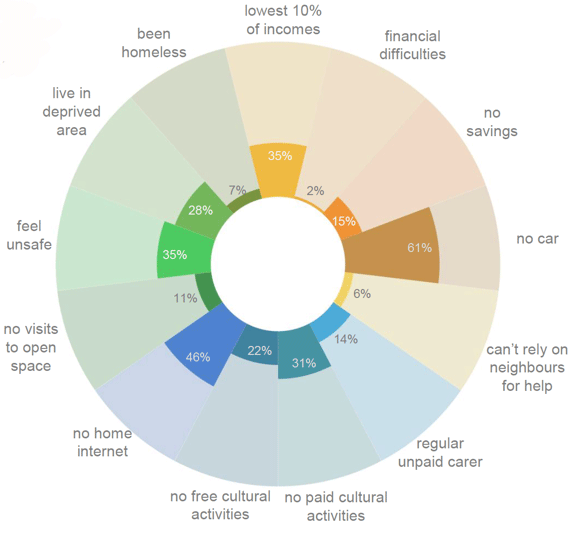
How to help them
As this group does not display disadvantage in almost all of the remaining poverty indicators, it may be a poor use of resource to invest heavily in interventions for this group. Nonetheless, investing time and resources into providing financial advice regarding the use of limited pensions incomes would be wise - this group may have 20 or more years in retirement to make their pensions last.
However, the energy and relative youth of this group could be captured as a means of helping older people in the previous three groups. In 'Building Companionship' (2016), Demos discussed the concept of 'socialisers' - older people who are already sociable, and who often take an active role in organising activities to be enjoyed not only by themselves but also by their wider community (Wood and Salter, 2016).
Older people in this group could be encouraged to become 'socialisers' - organisers, supporters or befrienders of older people who are further along in age, in poorer health, or more isolated. As most people in this group are single women, they may relish the opportunity to make new friends - and, as discussed with respect to 'disengaged couples' above, an expanded social network can only help them as they become older and their health and/or mobility declines in the future. While 'Building Companionship' focused on socialisers within retirement housing schemes, socialisers need not be confined to these environments - they could make a contribution in the wider community too, engaging the most isolated older people who are living alone.
Socio-demographic characteristics of the 'younger active
singles'
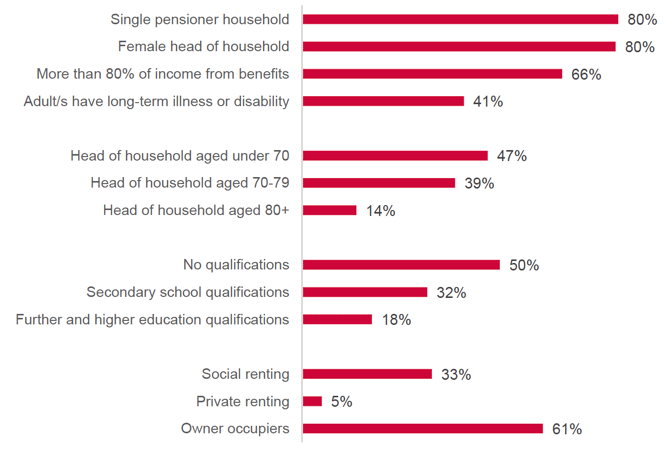
Older age: 'Younger socially engaged couples'
Who they are
This group are one of the youngest of the older cohort in poverty, and largely composed of couples. Important factors in explaining why this group is the least deprived according to most of the poverty indicators are that they are relatively healthy, better educated and home owners, suggesting they had successful working lives, despite experiencing a dip in their income upon retirement.
'Younger active singles' and 'younger socially engaged couples' are quite similar in many ways. It is possible therefore that women in 'younger engaged couples' become 'younger active singles' if they are bereaved (or separated).
How to reach this group
Given their high levels of social engagement, this group can be identified by community groups in which older people participate. It is possible that former employers could reach out to this group as well as their relative youth means they may only be recently retired.
Breakdown of poverty indicators for the 'younger socially
engaged couples'
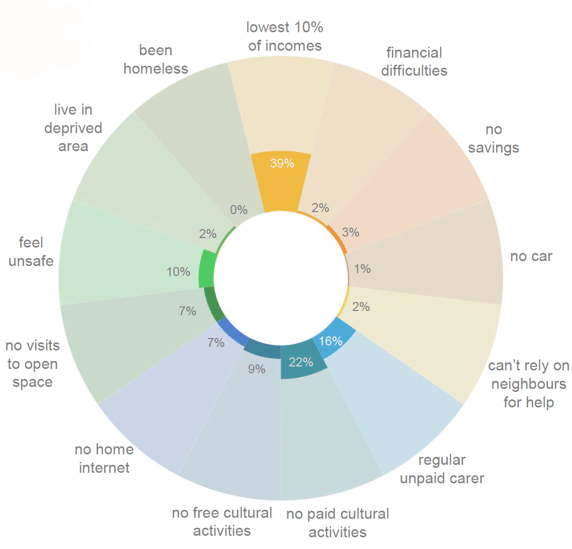
How to help this group
The focus for this group should be on measures that will prevent them from becoming more affected by poverty in the future - particularly focusing on isolation and housing issues. As they are the youngest of the pensioner groups, they would also benefit from financial advice and investment in financial capability to ensure their modest pensions and savings, and their housing assets, are used wisely to maintain a relatively decent standard of living for the 20 or more years they may have in retirement.
Similar to 'younger active singles', this group could make highly effective socialisers - perhaps even more so due to being more mobile and being able share the work involved in planning and organising activities. They are also the group most likely to live in rural areas, so 'younger socially engaged couples' living in rural areas would be particularly helpful in visiting older people in this cohort living in remote locations that are difficult to access without a car. The social networks gained in these roles would be effective in preventing people in this group from experiencing loneliness in later life.
The vast majority of this group are homeowners. While this arrangement may be manageable in the present, it may become unmanageable as this group grow older and their health declines. Furthermore, it could perpetuate isolation when one person in the couple is widowed. As with 'socially disengaged couples', a better outcome could result from 'younger socially engaged' couples downsizing (either into a smaller, more accessible home, or retirement housing) sooner rather than later.
Socio-demographic characteristics of the 'younger socially
engaged couples'
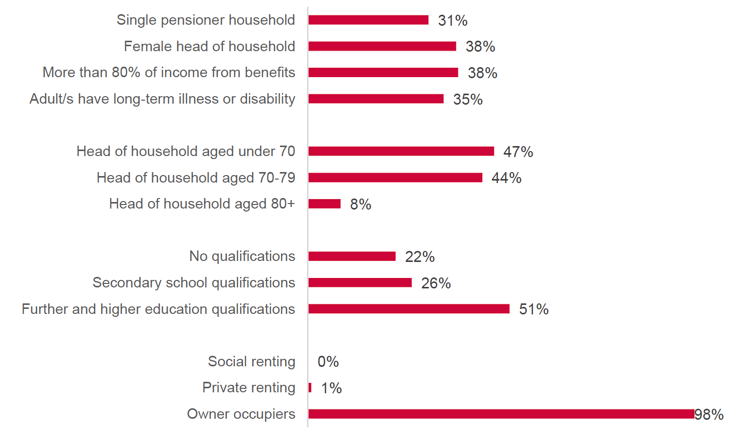
Contact
There is a problem
Thanks for your feedback